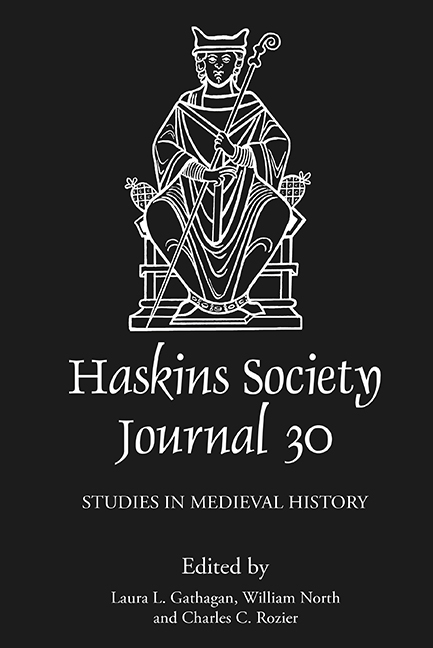Book contents
- Frontmatter
- Contents
- List of Figures and Tables
- Editor's Note
- Abbreviations
- 1 Beyond Corfe: Ælfthryth's Roles as Queen, Villain, and Former Sister-in-law
- 2 Medieval Curses and Their Users
- 3 ‘Although He Was His Nephew’: A Study of Younger Hautevilles Either Side of the Sea
- 4 Nearly Gold and Nearly Perfect? Copper, Meaning, and Materiality in Norman Sicily
- 5 Bound by Loyalty: Conflict, Communication and Group Solidarity in Early Twelfth-Century Southern Italy
- 6 Hugh of Lincoln and Adam of Eynsham: Angevin Kingship Reconsidered
- 7 Earthly Kings, Heavenly Jerusalem: Ralph Niger's Political Exegesis and the Third Crusade
- 8 ‘Holy Christendom's New Colony’: The Extraction of Sacred Matter and the Colonial Status of the Latin Kingdom of Jerusalem
- 9 Medieval French Peasants: The New Frontier?
1 - Beyond Corfe: Ælfthryth's Roles as Queen, Villain, and Former Sister-in-law
Published online by Cambridge University Press: 30 April 2020
- Frontmatter
- Contents
- List of Figures and Tables
- Editor's Note
- Abbreviations
- 1 Beyond Corfe: Ælfthryth's Roles as Queen, Villain, and Former Sister-in-law
- 2 Medieval Curses and Their Users
- 3 ‘Although He Was His Nephew’: A Study of Younger Hautevilles Either Side of the Sea
- 4 Nearly Gold and Nearly Perfect? Copper, Meaning, and Materiality in Norman Sicily
- 5 Bound by Loyalty: Conflict, Communication and Group Solidarity in Early Twelfth-Century Southern Italy
- 6 Hugh of Lincoln and Adam of Eynsham: Angevin Kingship Reconsidered
- 7 Earthly Kings, Heavenly Jerusalem: Ralph Niger's Political Exegesis and the Third Crusade
- 8 ‘Holy Christendom's New Colony’: The Extraction of Sacred Matter and the Colonial Status of the Latin Kingdom of Jerusalem
- 9 Medieval French Peasants: The New Frontier?
Summary
In March of 978 the teenaged Edward, king of the English, travelled to Corfe in Dorset to visit his stepmother, the dowager Queen Ælfthryth, and younger half-brother, Æthelred. The young king was killed there, probably by his half-brother's retainers, and later honoured as St Edward the Martyr. Ælfthryth received increasing amounts of blame for the death of Edward and during the twelfth century was cast in the familiar, if one-dimensional, role of the evil stepmother. This villainous archetype is the filter through which post-Conquest writers viewed her and most modern scholars have engaged with her life. Yet, this is not the start of her story and the death of her stepson was not the only scandalous tale medieval authors associated with this particular Anglo-Saxon queen. Twelfth-century writers provide a salacious twist to her first marriage in which Edgar, and sometimes Ælfthryth, conspire to kill her previous husband. Although these narratives and the motives behind them are interesting in their own right, the less sensational contemporary royal charters deserve a closer examination. Such documents are not only important for understanding the ecclesiastical and secular figures surrounding the royal family at royal assemblies but also provide a surviving contemporary snapshot of such a gathering unburdened by hindsight. Charter evidence suggests that Ælfthryth was probably already a controversial figure during the reign of her second husband, King Edgar. She became queen during a time when that particular role was expanding beyond the king's bed companion. There is also a good indication that her remarriage to the king was not well accepted in certain circles. Charters dated to the first years of her tenure as queen indicate that her former brothers-in-law may have taken issue with the king's choice of a new bride. This article explores her complex relationship with the family of her first husband, the powerful kin-group of Ealdorman Æthelstan ‘Half-King’ of East Anglia. Foundational changes to Anglo-Saxon queenship also occurred during Ælfthryth's life. Her posthumous reputation is best analysed within these contexts.
- Type
- Chapter
- Information
- The Haskins Society Journal 302018. Studies in Medieval History, pp. 1 - 20Publisher: Boydell & BrewerPrint publication year: 2020

